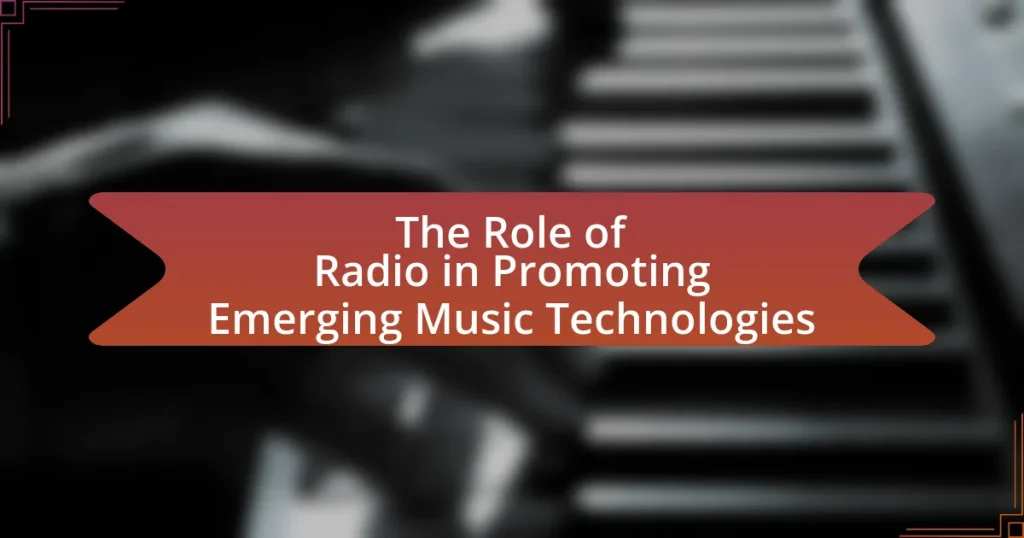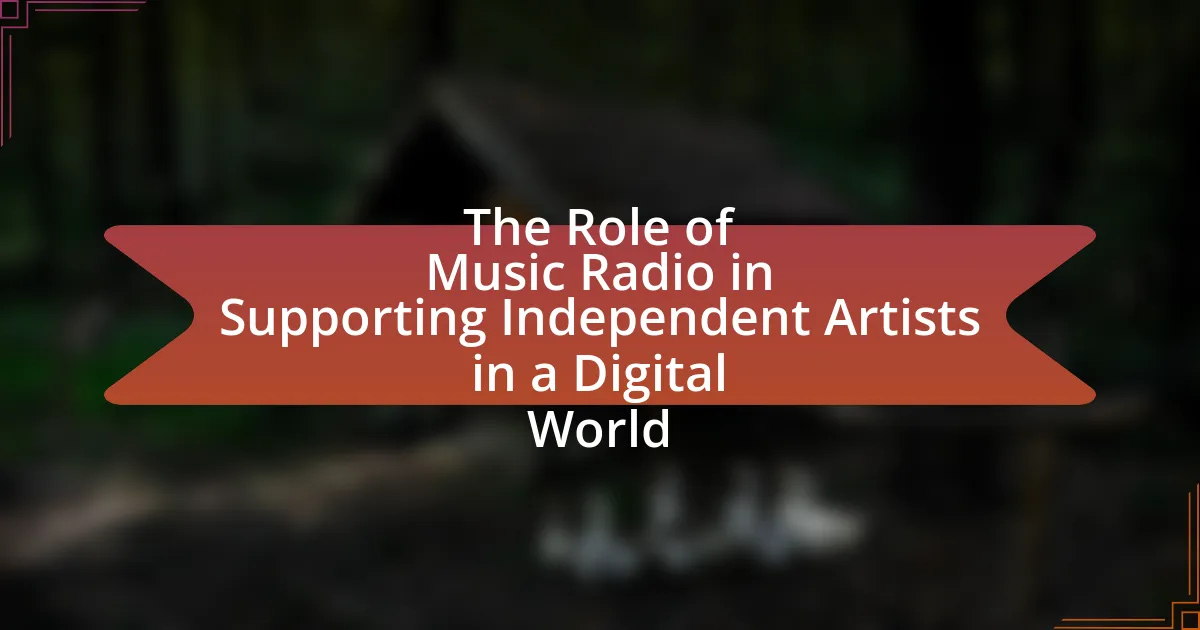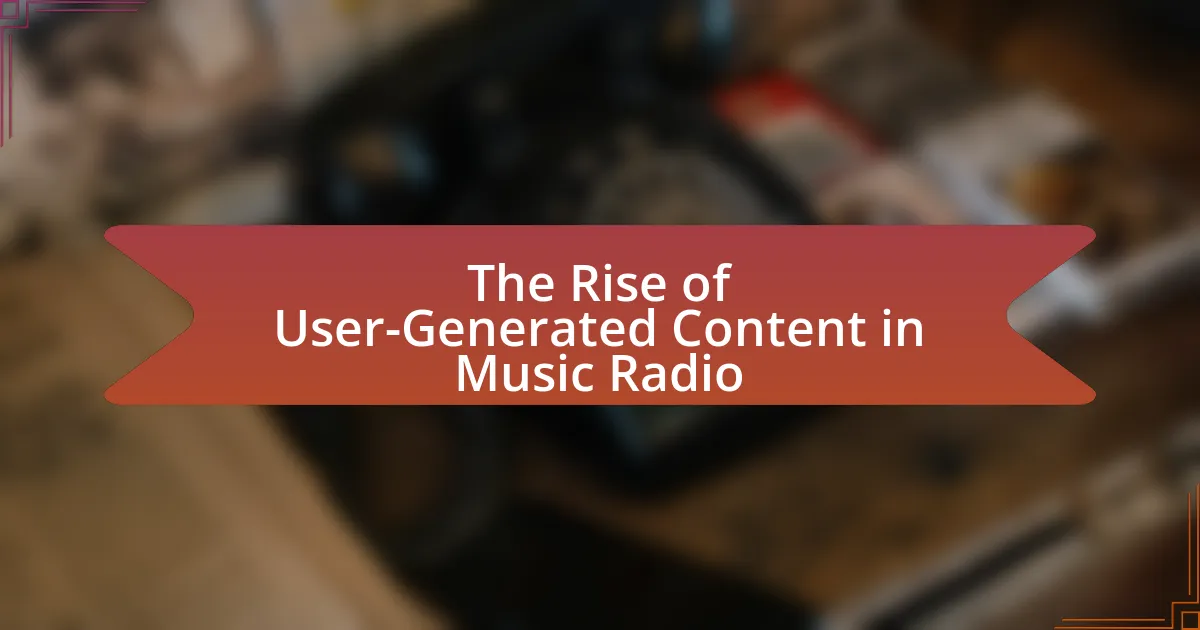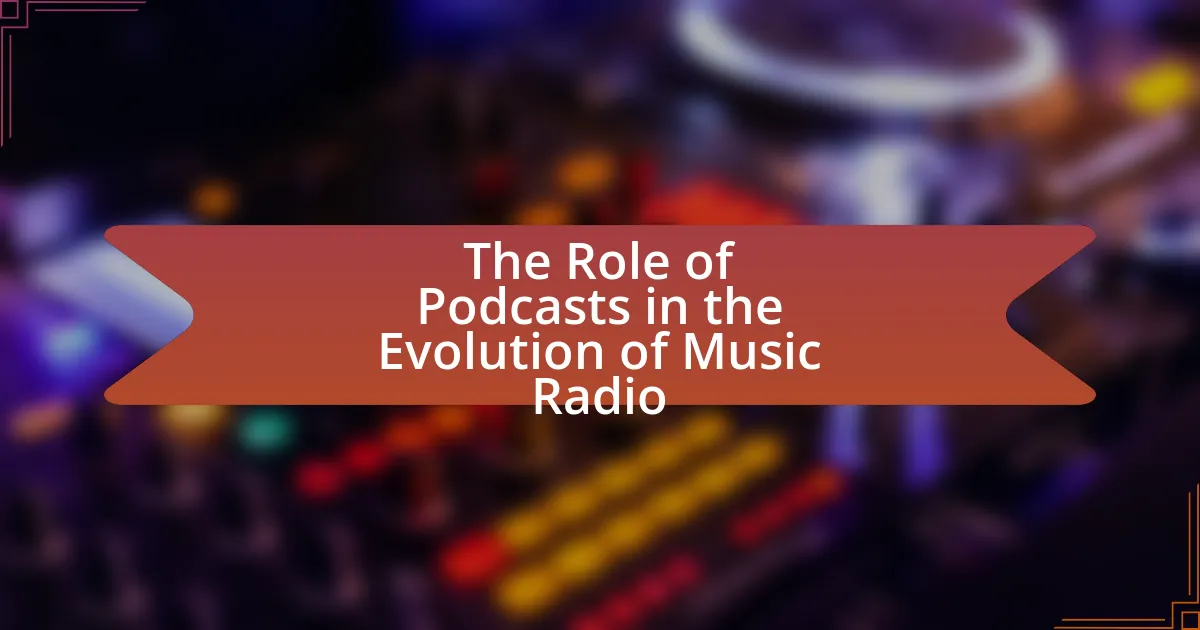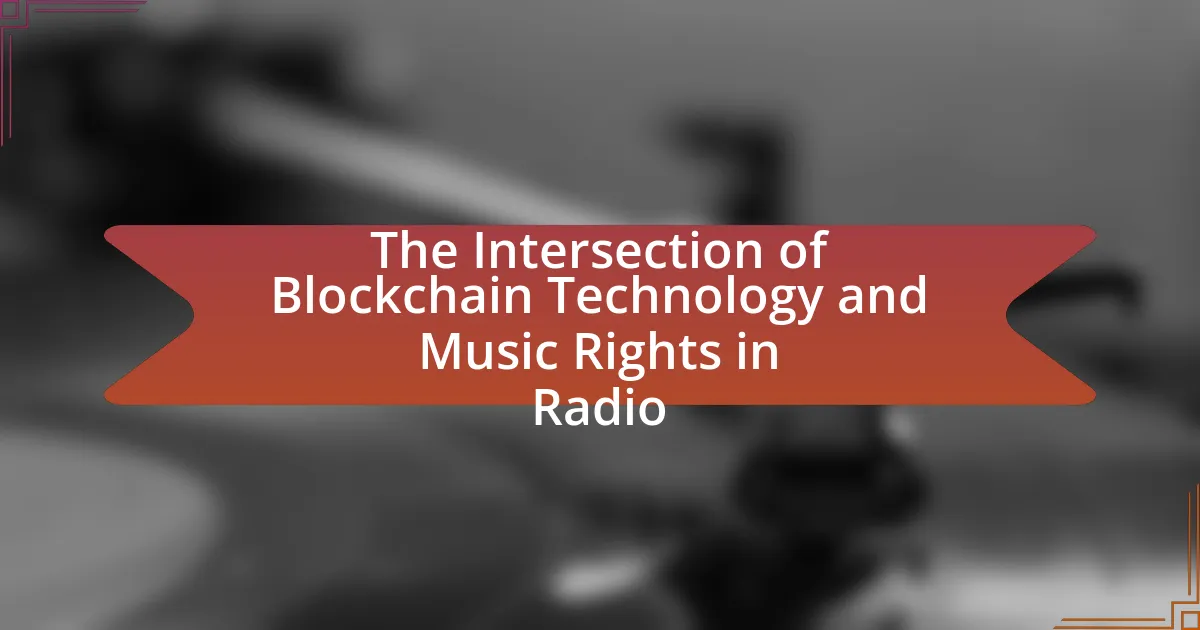The article examines the significant role of radio in promoting emerging music technologies, highlighting its function as a platform for new artists and innovative sounds. It discusses how radio influences the adoption of technologies such as streaming services and digital audio broadcasting, facilitating listener engagement and discovery. Key emerging technologies promoted by radio include interactive radio services and digital platforms, which enhance the music experience. The article also addresses the challenges radio faces in adapting to changing listener habits and technological advancements, while outlining strategies for effective promotion and collaboration with artists and tech companies. Finally, it explores future trends and best practices for radio in the context of music technology promotion.
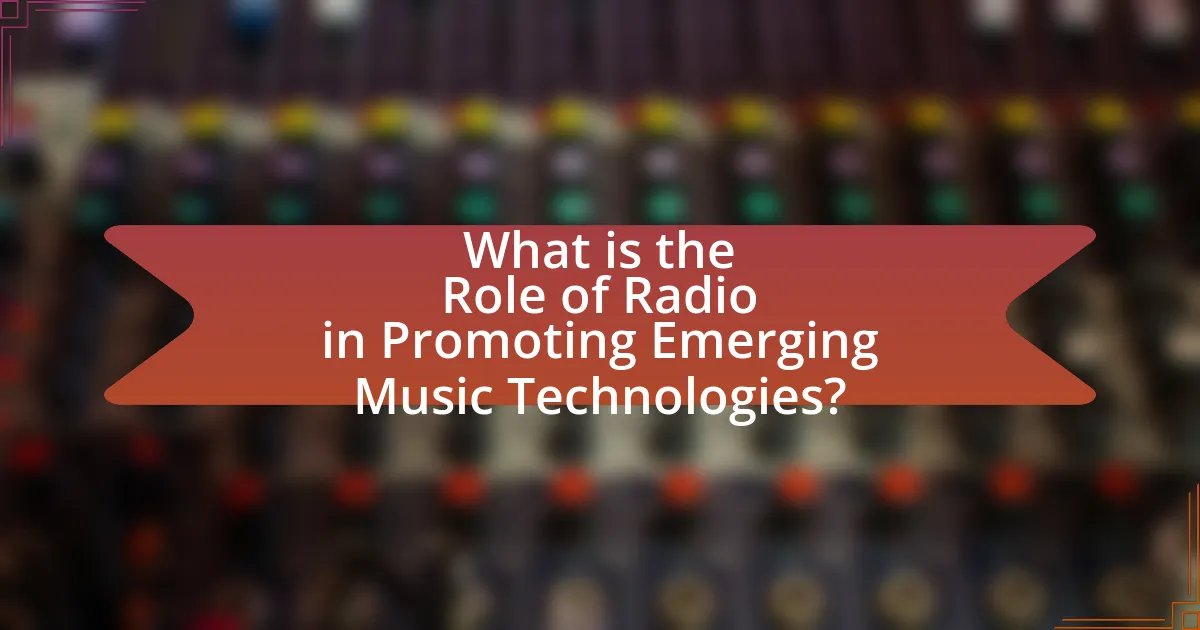
What is the Role of Radio in Promoting Emerging Music Technologies?
Radio plays a crucial role in promoting emerging music technologies by providing a platform for new artists and innovative sounds to reach a wider audience. Through airplay, radio stations can introduce listeners to cutting-edge music formats, such as digital streaming and interactive audio experiences, which are often tied to technological advancements. For instance, radio has historically been a key player in the adoption of new genres and styles, as seen with the rise of electronic music in the 1980s, where stations like BBC Radio 1 showcased emerging artists and trends. This exposure not only helps artists gain recognition but also encourages listeners to engage with new technologies, such as music apps and streaming services, thereby driving the overall growth of the music industry.
How does radio influence the adoption of new music technologies?
Radio significantly influences the adoption of new music technologies by serving as a primary platform for exposure and promotion. When radio stations incorporate new technologies, such as digital streaming or high-definition audio, they not only showcase these innovations but also encourage listeners to engage with them. For instance, the rise of internet radio and streaming services has been propelled by traditional radio’s adaptation to digital formats, leading to increased listener accessibility and engagement. Research indicates that radio airplay can boost the popularity of new music technologies, as seen with the transition from vinyl to digital formats in the late 20th century, where radio played a crucial role in familiarizing audiences with new sound quality and delivery methods.
What are the key emerging music technologies currently promoted by radio?
Key emerging music technologies currently promoted by radio include streaming platforms, digital audio broadcasting (DAB), and interactive radio services. Streaming platforms, such as Spotify and Apple Music, are increasingly integrated into radio programming, allowing listeners to access vast music libraries and personalized playlists. Digital audio broadcasting enhances sound quality and provides additional channels, improving listener experience. Interactive radio services, like those offered by platforms such as iHeartRadio, enable audience engagement through features like song requests and real-time feedback, fostering a more interactive listening environment. These technologies reflect the evolving landscape of music consumption and the role of radio in adapting to new trends.
How does radio facilitate the discovery of these technologies by listeners?
Radio facilitates the discovery of emerging music technologies by providing a platform for artists and innovators to showcase their work to a broad audience. Through regular programming, radio stations introduce listeners to new music formats, digital tools, and innovative sound production techniques. For instance, stations often feature segments dedicated to new technology releases or interviews with creators, which directly informs listeners about advancements in music technology. Additionally, radio’s ability to reach diverse demographics ensures that these technologies are accessible to a wide range of listeners, thereby enhancing public awareness and interest in the latest developments in the music industry.
Why is radio a significant platform for emerging music technologies?
Radio is a significant platform for emerging music technologies because it provides widespread access to diverse audiences, facilitating the discovery and promotion of new artists and innovations. The medium’s ability to reach millions of listeners instantly allows emerging technologies, such as streaming services and digital audio formats, to gain traction and visibility. For instance, according to a 2021 Nielsen report, radio remains the most consumed audio platform, with 92% of Americans tuning in weekly, highlighting its crucial role in shaping music trends and introducing new sounds to the public. This extensive reach enables emerging music technologies to leverage radio’s established infrastructure for effective marketing and audience engagement.
What unique advantages does radio offer over other media in promoting music technologies?
Radio offers unique advantages in promoting music technologies through its broad reach, immediacy, and ability to create a personal connection with listeners. Unlike other media, radio can deliver music content instantly to a wide audience, often in real-time, which is crucial for promoting new technologies and trends as they emerge. For instance, radio stations can quickly adapt their playlists to feature the latest music technologies, such as streaming services or digital audio formats, thereby influencing listener preferences and behaviors. Additionally, radio hosts often engage in discussions about new technologies, providing context and recommendations that enhance listener understanding and interest. This interactive element fosters a sense of community and loyalty among listeners, which is less prevalent in other media forms.
How does radio’s reach impact the success of emerging music technologies?
Radio’s reach significantly impacts the success of emerging music technologies by providing a platform for widespread exposure and audience engagement. When radio stations incorporate new music technologies, such as streaming services or digital platforms, they can introduce innovative sounds and artists to a larger audience, thereby enhancing the visibility and acceptance of these technologies. For instance, a study by the Pew Research Center found that 92% of Americans listen to the radio weekly, indicating its substantial influence in shaping music trends. This extensive reach allows emerging technologies to gain traction, as listeners often discover new music through radio playlists and programming, leading to increased adoption and integration into mainstream culture.
What challenges does radio face in promoting emerging music technologies?
Radio faces significant challenges in promoting emerging music technologies, primarily due to its traditional broadcasting model and audience preferences. The reliance on established formats and playlists limits the integration of new technologies, as radio stations often prioritize familiar content to retain listeners. Additionally, the rapid pace of technological advancement can outstrip radio’s ability to adapt, resulting in a disconnect between emerging platforms and traditional broadcasting. For instance, the rise of streaming services has shifted listener habits, making it difficult for radio to compete for audience attention. Furthermore, regulatory constraints and limited resources can hinder radio’s capacity to experiment with and promote innovative music technologies effectively.
How do changing listener habits affect radio’s role in music technology promotion?
Changing listener habits diminish radio’s role in music technology promotion by shifting audience preferences towards on-demand streaming services and personalized playlists. As listeners increasingly favor platforms like Spotify and Apple Music, which offer tailored music experiences, traditional radio struggles to maintain relevance in promoting new technologies. For instance, a Nielsen report from 2021 indicated that 62% of U.S. adults preferred streaming services over radio for music discovery, highlighting a significant shift in listener behavior. This transition reduces radio’s influence in introducing emerging music technologies, as audiences are less likely to rely on radio for music recommendations and technological advancements.
What are the limitations of radio in showcasing new music technologies?
Radio has significant limitations in showcasing new music technologies primarily due to its reliance on traditional broadcasting formats and limited interactivity. Traditional radio often prioritizes established artists and genres, which restricts the exposure of innovative music technologies that may not fit conventional formats. Additionally, radio’s one-way communication model limits audience engagement and feedback, making it challenging to promote new technologies that thrive on listener interaction and participation. Furthermore, the regulatory constraints and commercial pressures faced by radio stations can hinder their ability to experiment with and adopt new technologies, resulting in a slower adaptation to emerging trends in the music industry.
How can radio effectively promote emerging music technologies?
Radio can effectively promote emerging music technologies by integrating them into programming and showcasing their capabilities to listeners. By featuring artists who utilize new technologies, such as digital audio workstations or innovative sound production techniques, radio can demonstrate the practical applications and benefits of these tools. For instance, stations can host live sessions or interviews with musicians who leverage technology like virtual reality or AI in their music creation, thus providing tangible examples of how these technologies enhance the music experience. Additionally, radio can collaborate with tech companies to create segments that educate listeners about the latest advancements, fostering a deeper understanding and interest in emerging music technologies.
What strategies can radio stations implement to enhance technology promotion?
Radio stations can enhance technology promotion by integrating interactive platforms, utilizing social media engagement, and hosting live demonstrations of new technologies. Interactive platforms, such as mobile apps or websites, allow listeners to engage with content, providing feedback and participating in polls, which increases listener investment in the technology being promoted. Social media engagement amplifies reach; for instance, stations can share exclusive content or behind-the-scenes looks at new technologies, fostering a community around innovation. Hosting live demonstrations, such as on-air events or community workshops, allows audiences to experience new technologies firsthand, which can lead to increased interest and adoption. These strategies are supported by the growing trend of audience participation in media, as evidenced by a 2022 Nielsen report indicating that 70% of listeners engage with radio stations through social media platforms.
How can collaboration with artists and tech companies improve radio’s impact?
Collaboration with artists and tech companies can significantly enhance radio’s impact by integrating innovative technologies and fresh content that attract diverse audiences. For instance, partnerships with tech firms can facilitate the use of advanced analytics to tailor programming to listener preferences, thereby increasing engagement. Additionally, artists can leverage radio platforms to promote new music and connect with fans, as seen in initiatives like Spotify’s collaboration with radio stations to feature exclusive artist interviews and live performances. This synergy not only enriches the listening experience but also drives audience growth, evidenced by a 2021 Nielsen report indicating that radio remains a leading medium for music discovery, particularly when combined with digital platforms.
What are the future trends for radio in the context of music technology promotion?
Future trends for radio in the context of music technology promotion include increased integration of streaming services, enhanced interactivity through mobile apps, and the use of data analytics to tailor content to listener preferences. Radio stations are increasingly partnering with platforms like Spotify and Apple Music to provide seamless access to music, allowing listeners to discover new artists and tracks directly from broadcasts. Additionally, mobile applications are evolving to offer interactive features such as song requests and real-time feedback, fostering greater listener engagement. Data analytics enables radio stations to analyze listener habits and preferences, allowing for more personalized programming that aligns with audience interests. These trends reflect the ongoing adaptation of radio to the digital landscape, ensuring its relevance in promoting emerging music technologies.
How might advancements in technology change radio’s promotional strategies?
Advancements in technology will significantly change radio’s promotional strategies by enabling more targeted and interactive marketing approaches. With the rise of data analytics and artificial intelligence, radio stations can analyze listener preferences and behaviors to tailor promotions specifically to individual audiences, enhancing engagement. For instance, the integration of social media platforms allows radio stations to create real-time interactions with listeners, promoting shows and events through live streaming and audience participation. Additionally, the use of mobile applications and podcasts provides new channels for reaching audiences, allowing for on-demand content that can be promoted through push notifications and personalized recommendations. These technological advancements facilitate a more dynamic and responsive promotional landscape for radio, ultimately leading to increased listener loyalty and expanded reach.
What role will digital platforms play in the evolution of radio’s music technology promotion?
Digital platforms will significantly enhance radio’s music technology promotion by providing broader reach and targeted engagement. These platforms enable radio stations to distribute content across various channels, including social media and streaming services, thus increasing visibility for emerging music technologies. For instance, platforms like Spotify and Apple Music allow radio shows to integrate playlists and promote new artists directly to listeners, leveraging data analytics to tailor recommendations. This integration not only amplifies the promotional efforts of radio but also fosters collaboration between artists and technology developers, as seen in initiatives like the partnership between radio stations and music tech startups to showcase innovative tools.
What best practices should radio stations follow to promote emerging music technologies?
Radio stations should actively engage with emerging music technologies by incorporating them into their programming and promotional strategies. This includes featuring new music platforms, utilizing innovative broadcasting techniques, and collaborating with tech companies to showcase advancements in music distribution. For instance, stations can host live sessions using virtual reality or augmented reality to enhance listener experiences, as seen in initiatives by stations like KEXP, which have successfully integrated live streaming and audience interaction. Additionally, radio stations should leverage social media to promote these technologies, creating campaigns that highlight their benefits and encourage listener participation. By adopting these practices, radio stations can effectively support and promote the evolution of music technologies while enhancing their relevance in the industry.
